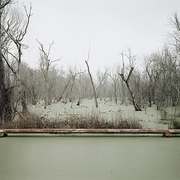A new exhibit in the Carleton College Perlman Teaching Museum highlights the complex forces shaping the Mississippi River landscape. “Petrochemical America: Project Room” is a unique collaboration between celebrated photographer Richard Misrach and landscape designer Kate Orff. Based on the book Petrochemical America (Aperture, 2012), the project brings into focus the complex economic and ecological forces that have shaped the industrial landscapes of the lower Mississippi River’s “Cancer Alley.”
The public is invited to an opening reception for “Petrochemical America: Project Room” on Thursday, April 3 from 7 to 9 p.m. in the Weitz Center for Creativity Commons. Along with light refreshments, the reception will include a tour of the exhibit led by Minneapolis artist and photographer Paul Shambroom, who will explore issues of power through grand landscape imagery.
“Petrochemical America: Project Room” uses an open studio format to juxtapose the California-based Richard Misrach’s large format photographs with New York City landscape architect Kate Orff’s data visualizations. The exhibition features Misrach’s 1998 and 2010 photographs, taken along 150 miles of the lower Mississippi River, where long-term chemical production occurs simultaneously with an alarming spike in certain cancers. Misrach’s work investigates the historical, socioeconomic, and environmental conditions that characterize the region through expansive images, including a modest family home juxtaposed with a massive grain elevator, the “Norco cumulus” cloud hovering over a Shell Oil refinery, and eerily beautiful scenes of despoiled river-scapes.
Alongside Misrach’s photographs are a collection of Kate Orff’s “throughlines,” speculative drawings that use research and data mapping to uncover the ways petrochemical resource extraction has transformed communities along the Chemical Corridor and beyond.
Taken as a whole, Petrochemical America: Project Room offers a penetrating look at how the petrochemical industry impacts a specific place, and invites further investigations into the implications for a global society.
“The Mississippi River is one of our nation’s great natural treasures, like Yosemite, and yet it’s being treated like a trash dump,” says Misrach. “But the reality is, oil is just too big. It is a huge economic driver; this nation is dependent on it in every way—for goods and jobs. The people and communities along the river will remain the sacrifice zone for the rest of us, until oil and other industries dependent on the river walk away. In the end, we needed to create a deep but more sober study of the issues, with the hopes that real, albeit less utopian, solutions can be found.”
Two additional “mini” exhibitions complement “Petrochemical America: Project Room.” Carleton College will also showcase James D. Butler’s paintings of the St. Paul Power Plant, entitled “Rapture/Rupture: An Upper Mississippi View,” and Paul Shambroom’s “Strategic Petroleum Reserve Landscapes,” large photographic landscapes of the U.S. Strategic Petroleum Reserve sites.
About the artists
Born in 1949 in Los Angeles, Richard Misrach is one of the most influential and prolific artists of his generation. In the 1970’s, he helped pioneer the renaissance of color photography and large scale presentation practises that are widespread today. Best known for the epic series, Desert Cantos, a multifaceted study of place, he has worked in the landscape for over 40 years. Other notable bodies of work include documentation of the Mississippi River industrial corridor known as Cancer Alley; the rigorous study of weather and time in his serial photographs of the Golden Gate; and On the Beach, an aerial perspective of human interaction and isolation. Recent projects point in experimental directions; in Destroy this Memory (Aperture, 2010), he builds a narrative with digital pocket camera photos capturing graffiti images created during Hurricane Katrina.
Misrach’s photographs are held in museum collections worldwide, including the Museum of Modern Art, the Whitney Museum of American Art and the Metropolitan Museum of Art in New York; the National Gallery of Art, Washington, DC, and the San Francisco Museum of Modern Art. A major midcareer survey was organized by the Houston Museum of Fine Arts in 1996. Beginning in 2007, the exhibit On the Beach traveled to the Art Institute of Chicago, the High Museum of Art, and the National Gallery of Art. In 2012 and 2013, Misrach’s Cancer Alley project was on view at the High Museum of Art in Atlanta and the Cantor Center at Stanford. This work combines with drawings and maps by landscape architect Kate Orff to comprise the exhibition Petrochemical America: Project Room. Misrach and Orff’s recent publication, Petrochemical America, was selected by the American Institute of Graphic Design (AIGA) as one of the best books of 2012.
Kate Orff is an assistant professor of Architecture and Urban Design at Columbia University and the founder of SCAPE, a landscape architecture studio in New York City. Her work weaves together sustainable development, design for biodiversity, and community-based change. Orff’s 2010 exhibition at the Museum of Modern Art, Oystertecture, reimagined the polluted Gowanus Canal as part of a community process and ecologically revitalized New York harbor. Kate's other books include Gateway: Visions for an Urban National Park. She was named a United States Artist Fellow in 2012.
SCAPE, in collaboration with Rogers Marvel, is currently working on a schematic design for Water Works, a proposed Minneapolis park located along the Central Riverfront, the stretch of the Mississippi River below St Anthony Falls bordering the old mill district.
This exhibition is made possible through a collaboration with the Aperture Foundation; learn more online at www.aperture.org.
“Petrochemical America: Project Room” will be on display through May 4 in the Braucher Gallery and Kaemmer Family Gallery of the Perlman Teaching Museum, located in the Weitz Center for Creativity (320 Third Street in Northfield). Admission to the museum is free. Museum hours are 11 a.m. to 6 p.m., Monday-Wednesday; 11 a.m. to 9 p.m., Thursday and Friday; and 12 p.m. to 4 p.m. on Saturday and Sunday. For more information, contact Laurel Bradley, director and curator of the Perlman Teaching Museum, at (507) 222-4342 or visit online at go.carleton.edu/museum.




